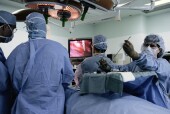
MONDAY, Oct. 18 (HealthDay News) — Patients undergoing surgery still risk falling victim to stunning medical mistakes, ranging from an operation on the wrong surgical site to undergoing surgery intended for another patient, a new study finds.
To try to curb the rate of surgical errors, the Joint Commission in 2004 introduced a universal protocol for all hospitals, ambulatory care facilities and office-based surgical facilities to follow. However, even though these steps have largely been adopted, errors continue to happen, the researchers reported.
“What is shocking about the data is that each and every one of those wrong-site, wrong-patient errors is really an event that should never happen,” said study author Dr. Philip F. Stahel, a visiting associate professor at the University of Colorado School of Medicine in Denver.
“These happen much more frequently than we think. This is just the tip of the iceberg,” he said. “Introducing the universal protocols have not reduced the frequency of these events.”
The universal protocol requires three critical steps: a pre-procedure verification, marking the correct surgical site, and a “time-out” for the operating staff just before the surgery.
The report is published in the October issue of the Archives of Surgery.
For the study, Stahel’s team collected data on surgical errors from a company that provides liability insurance to 6,000 doctors in Colorado.
In the database, doctors reported 27,370 adverse events that happened between January 2002 and June 2008. Among these, the researchers identified 25 wrong-patient and 107 wrong-site operations.
Of these, five patients who received unnecessary surgery and 38 who received wrong-site operations were significantly harmed, the researchers found. In addition, one patient who had a wrong-site procedure died.
In looking for the reasons for these mistakes, Stahel’s group found diagnostic errors accounted for 56 percent of the operations on the wrong patient, and 100 percent — including one in which the wrong child was called to the operating room — were due to poor communication.
Among operations on the wrong part of the body, 85 percent were due to errors in judgment and 72 percent were due to not performing a “time-out” as required by the universal protocol. Time-out is a common occurrence before an operation begins, when all those in the operating room check that they have the right patient and that they know what part of the body they are operating on.
But a safety system alone cannot solve the problem, Stahel noted.
“Once we were fully responsible for our actions — now we hide behind a safety system that should cover the problem. The time-out is performed, but people are not mentally involved — the system alone cannot protect you from wrong-site surgery,” he said.
The blame for these mistakes falls across the medical profession, the researchers noted. The groups most frequently involved in operations on the wrong patient were internal medicine specialists, who were responsible for 24 percent of such mistakes, and clinicians involved in family or general medicine, pathology, urology, obstetrics-gynecology, and pediatrics, who were each responsible for 8 percent, according to the study.
The study also found that specialists in orthopedic surgery were responsible for 22.4 percent of the operations on the wrong surgical site, general surgeons for 16.8 percent, and anesthesiologists for 12.1 percent.
Stahel said doctors should take more personal responsibility for their errors. “We are going from a culture of blame to a culture of system safety, and we should move on to a culture of patient safety and accountability,” he said.
Dr. Martin A. Makary, an associate professor of surgery at Johns Hopkins University and author of an accompanying journal editorial, said that “a simple checklist does not solve the problem; it’s not that simple.”
“The culture has to change to promote people speaking up when they see a safety concern and promote good teamwork,” he said.
Makary noted that in many cases the people in the operating room don’t know each other and don’t even know each other’s names. In addition, the medical culture places doctors above nurses and other staff.
“A nurse or a low-level person in the surgical hierarchy may sense that something is not right, but they don’t speak up because they are intimidated by the operating room hierarchy,” he said.
Makary said that culture needs to change.
“By cutting through that culture and preserving what’s good about the hierarchy — that is, one person needs to make quick decisions, but getting rid of the intimidation, it actually improves safety,” he said.
Meanwhile, a study in the October issue of the Archives of Otolaryngology–Head & Neck Surgery, showed that a questionnaire filled out by patients before surgery could help identify patients at risk for complications.
In this study, people prone to obstructive sleep apnea who were found through the questionnaire appeared to have an increased risk of heart, lung and other complications following elective surgery, researchers found.
Dr. Tajender S. Vasu, and colleagues from Thomas Jefferson University Hospital in Philadelphia, concluded that “most patients with obstructive sleep apnea syndrome have undiagnosed conditions and are almost certainly at risk in the perioperative setting. The STOP-BANG questionnaire is a convenient and useful screening tool that appears to reliably identify patients who are at increased risk for postoperative complications.”
More information
For more information on patient safety, visit the Joint Commission.

